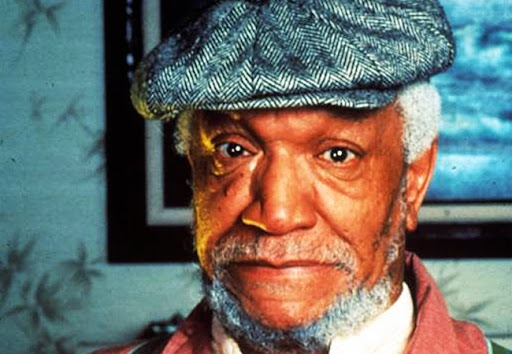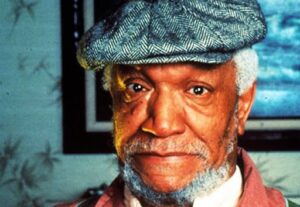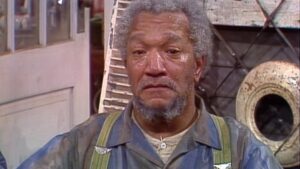
How Sanford and Son Cleaned Up Redd Foxx’s Act to Create a TV Icon (p1)

Fred G. Sanford was a junk man, and Redd Foxx was the master of trash talk. Sanford and Son turns 50.
Sanford and Son, the first mainstream, primetime sitcom in television history with an almost-all Black cast, debuted on NBC on Jan. 14, 1972. Created by Norman Lear, and starring legendary “blue” comedian Redd Foxx as an African American bigot, it was seen as a direct answer to CBS’ All in the Family. But the Bunker family series was a social satire which took its laughs seriously. The Sanfords presented pure comedy, any lessons it taught were intentionally coincidental. The most controversial part of the show, when it first aired, was its lead actor.
Foxx was already an underground comedy legend when Cleavon Little, best known for his role as Sheriff Bart in Mel Brooks’ Blazing Saddles, suggested him for the lead in the mid-season replacement. Little wasn’t available, but worked with Foxx on Ossie Davis’s 1970 neo-noir film Cotton Comes to Harlem. Before Foxx played the junk dealer stuck with the bale of genuine Mississippi cotton, he was known as the “King of the Party Records.”
In a time of repressed standup, Foxx worked notoriously “blue.” He agreed to clean up his act for television, but consistently fought to keep Sanford and Son authentically funny. Born John Elroy Sanford, raised on Chicago’s South Side, and relocated to Harlem, he was known for keeping it real. In The Autobiography of Malcolm X (1965), Malcolm X called “’Chicago Red,’ the funniest dishwasher on this earth.” Foxx started out as a singer, and ate half a bar of soap to get out of the draft during World War II. He got heart palpitations during the physical. But not “the big one, Elizabeth,” it was only a warm-up to one of the show’s running gags, which Foxx stole from his own mother.
“I’m 65. People say I look 55. I feel 45. I’d settle for 35 and you make me feel 25.”
The character Fred G. Sanford is a 65-year-old widower on Sanford and Son. Foxx was 49 when the series began, but personalized the part and the show. Fred Sanford was named after Foxx’s brother, who died five years earlier. Lamont Sanford, played by Demond Wilson on the series, was named after Lamont Ousley, who was in a washtub band with Redd when they were both teenagers.

While published reports contradict whether Wilson and Foxx met in Las Vegas or on set for the first time, their chemistry was instantaneous, and their timing was expert. There is a palpably genuine affection between the two actors. Wilson began acting after serving in the Army’s 4th Infantry Division in Vietnam from 1966 to 1968, when he was wounded and discharged as a decorated veteran. He began in live theater, and was featured in Broadway and Off Broadway shows. He acted in the films The Dealing (1970) The Organization (1971), and series like Mission: Impossible. Producer Bud Yorkin took notice when Wilson and Cleavon Little played burglars on All in the Family in 1971.
Foxx fought to cast school friend, and fellow blue stand-up, LaWanda Page, as Sanford’s Bible-thumping, finger-wagging sister-in-law, Esther Anderson. “Watch it, sucker,” Page’s burlesque dance title was “the Bronze Goddess of Fire,” and she could light cigarettes with her fingertips. Foxx also made sure the comic Slappy White was featured as a guest star. They’d both got their first break opening for blues singer Dinah Washington.
The rest of the cast was split between Fred’s friends Skillet (Ernest Mayhand), Leroy (Leroy Daniels), and Bubba Bexley (Don Bexley), and Lamont’s friend Rollo (Nathaniel Taylor). Grady Wilson, played by Whitman Mayo, went from the lovable wino, “Shady” Grady, to Lamont’s guardian when Foxx called in sick.
“Junk runs in the family. My granddad was a junkman in St. Louis and so was my uncle.”
All in the Family was based on the BBC1 television sitcom Till Death Do Us Part. Sanford in Son was based on the British sitcom Steptoe and Son, which starred Wilfrid Brambell (A Hard Day’s Night) and Harry H. Corbett as a father and son in the “rag and bone” business on Oil Drum Lane. Producers Lear and Yorkin relocated them to 9114 South Central, in the Watts section of Los Angeles.
Besides retooling many of the original series story ideas, many Sanford and Son plots are standard TV fare, like get-rich-quick schemes which go back to The Honeymooners. Grittier plot lines, like inflating collectible prices or feeding local cops some potent homegrown edibles, gave way to silly clichés like earthquakes, racehorses, and getting hypnotized to stop watching too much TV, in the later seasons.
